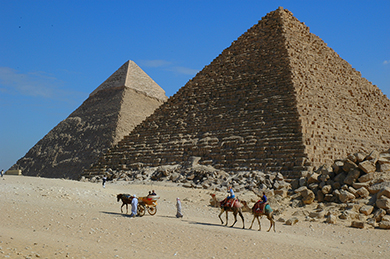1.5: How Economies Can Be Organized: An Overview of Economic Systems
- Last updated
- Save as PDF
- Page ID
- 17093
Think about what a complex system a modern economy is. It includes all production of goods and services, all buying and selling, all employment. The economic life of every individual is interrelated, at least to a small extent, with the economic lives of thousands or even millions of other individuals. Who organizes and coordinates this system? Who insures that, for example, the number of televisions a society provides is the same as the amount it needs and wants? Who insures that the right number of employees work in the electronics industry? Who insures that televisions are produced in the best way possible? How does it all get done?
There are at least three ways societies have found to organize an economy. The first is the traditional economy, which is the oldest economic system and can be found in parts of Asia, Africa, and South America. Traditional economies organize their economic affairs the way they have always done (i.e., tradition). Occupations stay in the family. Most families are farmers who grow the crops they have always grown using traditional methods. What you produce is what you get to consume. Because things are driven by tradition, there is little economic progress or development.

Command economies are very different. In a command economy, economic effort is devoted to goals passed down from a ruler or ruling class. Ancient Egypt was a good example: a large part of economic life was devoted to building pyramids, like those shown in Figure 1, for the pharaohs. Medieval manor life is another example: the lord provided the land for growing crops and protection in the event of war. In return, vassals provided labor and soldiers to do the lord’s bidding. In the last century, communism emphasized command economies.
In a command economy, the government decides what goods and services will be produced and what prices will be charged for them. The government decides what methods of production will be used and how much workers will be paid. Many necessities like healthcare and education are provided for free. Currently, Cuba and North Korea have command economies.

Although command economies have a very centralized structure for economic decisions, market economies have a very decentralized structure. A market is an institution that brings together buyers and sellers of goods or services, who may be either individuals or businesses. The New York Stock Exchange, shown in Figure 2, is a prime example of market in which buyers and sellers are brought together. In a market economy, decision-making is decentralized. Market economies are based on private enterprise: the means of production (resources and businesses) are owned and operated by private individuals or groups of private individuals. Businesses supply goods and services based on demand. (In a command economy, by contrast, resources and businesses are owned by the government.) What goods and services are supplied depends on what is demanded. A person’s income is based on his or her ability to convert resources (especially labor) into something that society values. The more society values the person’s output, the higher the income (think Lady Gaga or LeBron James). In this scenario, economic decisions are determined by market forces, not governments.
Most economies in the real world are mixed; they combine elements of command and market (and even traditional) systems. The U.S. economy is positioned toward the market-oriented end of the spectrum. Many countries in Europe and Latin America, while primarily market-oriented, have a greater degree of government involvement in economic decisions than does the U.S. economy. China and Russia, while they are closer to having a market-oriented system now than several decades ago, remain closer to the command economy end of the spectrum. A rich resource of information about countries and their economies can be found on the Heritage Foundation’s website, as the following Clear It Up feature discusses.
Note: What countries are considered economically free?
Who is in control of economic decisions? Are people free to do what they want and to work where they want? Are businesses free to produce when they want and what they choose, and to hire and fire as they wish? Are banks free to choose who will receive loans? Or does the government control these kinds of choices? Each year, researchers at the Heritage Foundation and the Wall Street Journal look at 50 different categories of economic freedom for countries around the world. They give each nation a score based on the extent of economic freedom in each category.
The 2015 Heritage Foundation’s Index of Economic Freedom report ranked 178 countries around the world: some examples of the most free and the least free countries are listed in Table. Several countries were not ranked because of extreme instability that made judgments about economic freedom impossible. These countries include Afghanistan, Iraq, Syria, and Somalia.
The assigned rankings are inevitably based on estimates, yet even these rough measures can be useful for discerning trends. In 2015, 101 of the 178 included countries shifted toward greater economic freedom, although 77 of the countries shifted toward less economic freedom. In recent decades, the overall trend has been a higher level of economic freedom around the world.
| Most Economic Freedom | Least Economic Freedom |
| 1. Hong Kong | 167. Timor-Leste |
| 2. Singapore | 168. Democratic Republic of Congo |
| 3. New Zealand | 169. Argentina |
| 4. Australia | 170. Republic of Congo |
| 5. Switzerland | 171. Iran |
| 6. Canada | 172. Turkmenistan |
| 7. Chile | 173. Equatorial Guinea |
| 8. Estonia | 174. Eritrea |
| 9. Ireland | 175. Zimbabwe |
| 10. Mauritius | 176. Venezuela |
| 11. Denmark | 177. Cuba |
| 12. United States | 178. North Korea |
In recent decades, the export/GDP ratio has generally risen, both worldwide and for the U.S. economy. Interestingly, the share of U.S. exports in proportion to the U.S. economy is well below the global average, in part because large economies like the United States can contain more of the division of labor inside their national borders. However, smaller economies like Belgium, Korea, and Canada need to trade across their borders with other countries to take full advantage of division of labor, specialization, and economies of scale. In this sense, the enormous U.S. economy is less affected by globalization than most other countries.
Table also shows that many medium and low income countries around the world, like Mexico and China, have also experienced a surge of globalization in recent decades. If an astronaut in orbit could put on special glasses that make all economic transactions visible as brightly colored lines and look down at Earth, the astronaut would see the planet covered with connections.
So, hopefully, you now have an idea of what economics is about. Before you move to any other chapter of study, be sure to read the very important appendix to this chapter called The Use of Mathematics in Principles of Economics. It is essential that you learn more about how to read and use models in economics.
Note: Decisions ... Decisions in the Social Media Age
The world we live in today provides nearly instant access to a wealth of information. Consider that as recently as the late 1970s, the Farmer’s Almanac, along with the Weather Bureau of the U.S. Department of Agriculture, were the primary sources American farmers used to determine when to plant and harvest their crops. Today, farmers are more likely to access, online, weather forecasts from the National Oceanic and Atmospheric Administration or watch the Weather Channel. After all, knowing the upcoming forecast could drive when to harvest crops. Consequently, knowing the upcoming weather could change the amount of crop harvested.
Some relatively new information forums, such as Facebook, are rapidly changing how information is distributed; hence, influencing decision making. In 2014, the Pew Research Center reported that 71% of online adults use Facebook. Facebook post topics range from the National Basketball Association, to celebrity singers and performers, to farmers.
Information helps us make decisions. Decisions as simple as what to wear today to how many reporters should be sent to cover a crash. Each of these decisions is an economic decision. After all, resources are scarce. If ten reporters are sent to cover an accident, they are not available to cover other stories or complete other tasks. Information provides the knowledge needed to make the best possible decisions on how to utilize scarce resources. Welcome to the world of economics!
Key Concepts and Summary
Societies can be organized as traditional, command, or market-oriented economies. Most societies are a mix. The last few decades have seen globalization evolve as a result of growth in commercial and financial networks that cross national borders, making businesses and workers from different economies increasingly interdependent.
References
The Heritage Foundation. 2015. "2015 Index of Economic Freedom." Accessed March 11, 2015. http://www.heritage.org/index/ranking.
Garling, Caleb. “S.F. plane crash: Reporting, emotions on social media,” The San Francisco Chronicle. July 7, 2013. www.sfgate.com/news/article/S...al-4651639.php.
Irvine, Jessica. “Social Networking Sites are Factories of Modern Ideas.” The Sydney Morning Herald. November 25, 2011.www.smh.com.au/federal-politi...#ixzz2YZhPYeME.
Pew Research Center. 2015. "Social Networking Fact Sheet." Accessed March 11, 2015. www.pewinternet.org/fact-shee...ng-fact-sheet/.
The World Bank Group. 2015. "World Data Bank." Accessed March 30, 2014. http://databank.worldbank.org/data/.
Glossary
- command economy
- an economy where economic decisions are passed down from government authority and where resources are owned by the government
- exports
- products (goods and services) made domestically and sold abroad
- globalization
- the trend in which buying and selling in markets have increasingly crossed national borders
- gross domestic product (GDP)
- measure of the size of total production in an economy
- imports
- products (goods and services) made abroad and then sold domestically
- market
- interaction between potential buyers and sellers; a combination of demand and supply
- market economy
- an economy where economic decisions are decentralized, resources are owned by private individuals, and businesses supply goods and services based on demand
- private enterprise
- system where the means of production (resources and businesses) are owned and operated by private individuals or groups of private individuals
- traditional economy
- typically an agricultural economy where things are done the same as they have always been done
- underground economy
- a market where the buyers and sellers make transactions in violation of one or more government regulations

